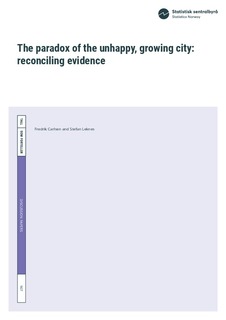The paradox of the unhappy, growing city: reconciling evidence
| dc.contributor.author | Carlsen, Fredrik | |
| dc.contributor.author | Leknes, Stefan | |
| dc.coverage.spatial | Norge | nb_NO |
| dc.date.accessioned | 2019-06-06T12:24:28Z | |
| dc.date.available | 2019-06-06T12:24:28Z | |
| dc.date.issued | 2019-05 | |
| dc.identifier.issn | 1892-753X | |
| dc.identifier.uri | http://hdl.handle.net/11250/2600179 | |
| dc.description | This work was supported by the Research Council of Norway grant number 255509 | en |
| dc.description.abstract | This paper attempts to explain why large cities tend to score low on indices of happiness/life satisfaction, while at the same time experiencing population growth. Using Norwegian survey and register data, we show that different population segments are behind these seemingly contradictory attributes of large cities. A minority of highly mobile citizens are satisfied with life in Norway’s biggest city, Oslo, and exhibits positive net in-migration to the city. A majority of less mobile groups are dissatisfied and tend to move out of Oslo, but these flows are too small to determine the overall migration pattern. Our results indicate that the Rosen-Roback framework for analysis of regional quality of life, which builds on the assumption of perfect mobility, is appropriate only for the most mobile segments of the population. | en |
| dc.language.iso | eng | nb_NO |
| dc.publisher | Statistisk sentralbyrå | nb_NO |
| dc.relation.ispartofseries | Discussion papers;907 | |
| dc.subject | Happiness | nb_NO |
| dc.subject | Life satisfaction | nb_NO |
| dc.subject | Quality of life | nb_NO |
| dc.subject | Big cities | nb_NO |
| dc.subject | Mobility | nb_NO |
| dc.title | The paradox of the unhappy, growing city: reconciling evidence | nb_NO |
| dc.type | Working paper | nb_NO |
| dc.description.version | publishedVersion | nb_NO |
| dc.source.pagenumber | 30 s. | nb_NO |
Tilhørende fil(er)
Denne innførselen finnes i følgende samling(er)
-
Discussion Papers [1002]
